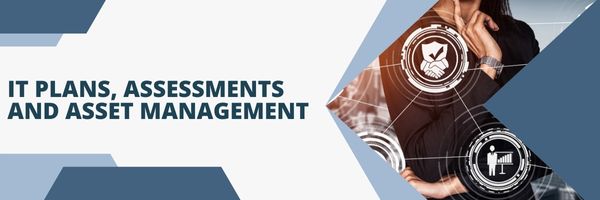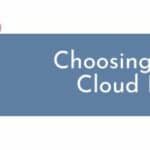IT plans, assessments, and asset management are the foundation of any IT department. The scope is typically vast and spread across technologies, business areas, and people. Developing a strategic plan is a critical asset for the business as it outlines how IT will support the key business goals set by your company. It also describes the strategic direction of IT and the “why” behind initiatives and investments.
Most companies set their strategy annually, and IT strategy and planning follows suit. Occasionally management will request a plan in two, three, or five year increments. The timelines largely depend on your business vertical, goals, internal resources, leadership team, and costs. Since tech changes rapidly, reviewing your plans and direction quarterly with stake holders will reduce friction and uncertainty throughout the business.
What is included in an IT plan?
Your IT plan defines how the business will operate and keep up with shifts in technology and the market. A strategic plan drives business transformation. The plan will help identify the technology, solutions, and data to deliver a better user and customer experience.
Your plan should cover these areas:
- Vision and strategy – What IT wants to achieve and how to get there.
- Goals- specific, measurable, achievable, relevant, and time-bound. Each should deliver against the broader goals that have been defined at the company level. For example, if the business is focused on improving time to market, an IT goal could be to increase new feature releases by 30% in each quarter.
- Initiatives: These are the high-level efforts that you need to complete to meet the goals. In short, initiatives bridge goals and tactical plans. As an example, adopting cloud-first solutions could be an initiative that helps the team reduce costs.
- Budget: Beyond managing recurring expenses and “just keeping the lights on,” you need to account for upcoming technology investments.
- Workflows: Your plan should also include processes and workflows that help the IT team collaborate across projects. Include the team members involved, roles and responsibilities, and any approval gates along the way. Documentation is key to keep everyone in sync.
How can you approach an IT plan?
IT plans, assessments, and asset management are all part of an IT plan. Your organization’s structure, industry, and IT methodologies will impact how you approach planning. Some IT teams take a waterfall approach to planning — they define the plans upfront, gather requirements, and do the work sequentially. Others take a more agile approach to planning. These teams define the high-level goals, then allow for ongoing adjustments to the plan. Either approach has its place if it enables you to meet your customers’ needs.
Consider the following questions to help guide the planning process:
- Who are the customers that we serve and what do they want to achieve?
- What are we delivering to our customers?
- How do our customers currently feel about our technologies and services?
- What are our goals for software development and delivery?
- Where do bottlenecks exist in current processes?
- How long do deployments currently take?
- What do we have automated now and what will we automate in the future?
- What is our biggest opportunity for innovation?
- How thorough is our vulnerability management program?
- What kinds of internal and external factors will impact our plan?
- How will we monitor and review the plan?
- What is the difference between an IT strategy and an IT plan?
Strategy vs. Plan.
People often use the terms interchangeably. It is easy to see why — both concepts refer to the work of achieving an end. Although IT strategies and plans are related, they are not the same thing. As an IT leader, first you must define the strategy and overall direction for your team. Then, you can craft a detailed plan to bolster that strategy.
By understanding how strategy and plans work together, you can propel results and deliver on your vision for the IT organization. You can better prioritize the work that brings real value and guides your team to make the right decisions about new technology, processes, and future areas of innovation.
What is an IT strategy?
An IT strategy describes what you want to achieve as a team or department and how it supports the business. It involves defining your overall vision and the goals and large themes of work that will help you get there. Setting and communicating the strategy keeps everyone focused on the desired end state.
An IT strategy includes the following components:
- Vision – The essence of what you want to achieve as an IT team.
- Customers – Types of customers that you serve, both internal and external.
- Competitors – The other IT organizations within your same industry or market.
- Business model – Elements of your organization or IT department that impact how you deliver technology.
- Goals – Time-bound, measurable objectives that describe how you plan to make progress towards your vision.
- Initiatives – Major themes of work you need to accomplish to meet your goals.
What is an IT plan?
An IT plan establishes the details of when and how you will achieve your strategic objectives. While your strategy will remain fixed, your plans will be dynamic. You will check in and adjust the plans as you go to make sure that the details of the work help you achieve your broader goals.
An IT plan includes the following components:
- Roadmap – What you will deliver, when you will deliver it, and why matters.
- Timeline – Dates you will deliver the work.
- Activities – Specific details about what you will deliver.
- Release schedule – Documented release process for the entire system’s development life cycle.
- Resources – People and budget required to achieve your goals.
- Roles and workflows – Roles, responsibilities, and processes that help you get work done.
Creating a well-defined strategy and a plan to achieve it is complex. In addition to defining the goals, initiatives, and detailed work, you need to be able to proactively spot weaknesses, determine the causes, and swiftly adjust. It takes a lot of effort to deliver on your plans without losing focus or velocity.
What are the components of an IT plan?
IT serves the entire organization. You manage technology across teams — working closely with other departments to deliver what they need. How do you know if the solutions you provide are truly helping the business meet its goals? The answer to this requires an IT strategy and a well-crafted plan.
Strategy sets the direction for how you will invest time and resources as an IT team to support the business. Your plan puts strategy in motion — with details on specific projects and areas of focus, roles and responsibilities, budgets, and more.
An IT plan has a few purposes. First, it helps your IT team focus on the work that will bring the most value to the organization. It keeps folks in sync and accountable for what you have committed to delivering. Your plan also provides other teams with visibility into the work you do and why it matters. Those teams are counting on you to continue to improve internal customer experiences — show them how with a clear plan.
Learn more about IT plans, assessments, and asset management in the next post that covers budgeting, forecasting and IT assessments.





